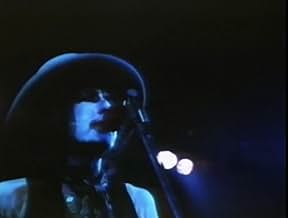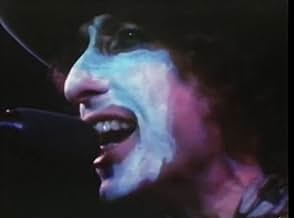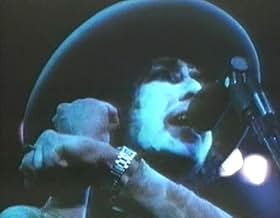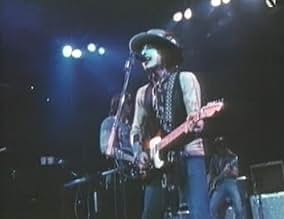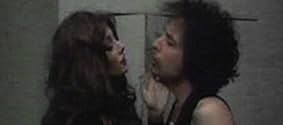Agrega una trama en tu idiomaBob Dylan on tour with the Rolling Thunder Revue in 1975; concert footage, documentary interviews and bizarre improvised character scenes.Bob Dylan on tour with the Rolling Thunder Revue in 1975; concert footage, documentary interviews and bizarre improvised character scenes.Bob Dylan on tour with the Rolling Thunder Revue in 1975; concert footage, documentary interviews and bizarre improvised character scenes.
- Premios
- 2 premios ganados en total
Ramblin' Jack Elliott
- Longheno de Castro
- (as Jack Elliott)
Ruth Tyrangel
- The Girlfriend
- (as Ruth Tyrangiel)
J. Stephen Soles
- Ramon
- (as Steven Soles)
- Dirección
- Guionista
- Todo el elenco y el equipo
- Producción, taquilla y más en IMDbPro
Opiniones destacadas
Renaldo And Clara was hit hard by critics, but was a true testimont that Bob Dylan (Robert Zimmerman) is the true modern leader of entertainment, and learder of social change.
P.S. I would also like to find somewhere where I can buy this movie.
P.S. I would also like to find somewhere where I can buy this movie.
The movie was filled with bad acting.
Plus, this movie did Joan Baez extremely dirty, erasing the fact that Joan Baez dated Bob Dylan in 1964. In 1965 Bob Dylan cheated on Joan Baez with Sara Lownds, then he goes & re-write history in Renaldo and Clara, turning Joan into the 'other woman' in his fairy tale marriage.
Warning: At the timestamp of 3 hours 20 minutes, Bob Dylan starts gargling. What is this? A Cofsils experdine gargle commercial?
Alternate title of the movie: This Movie is a Giant Middle Finger to Joan Baez. Dump Joan Baez, break her heart, marry the other girl named Sara Lownds, and then flip the tables and cast Joan Baez as the other girl instead. Talk about erasing the truth, eh? Plus, gargle a while to make audience confused and make people fools for 4 hours straight and pretend it to be a cinematic masterpiece".
Plus, this movie did Joan Baez extremely dirty, erasing the fact that Joan Baez dated Bob Dylan in 1964. In 1965 Bob Dylan cheated on Joan Baez with Sara Lownds, then he goes & re-write history in Renaldo and Clara, turning Joan into the 'other woman' in his fairy tale marriage.
Warning: At the timestamp of 3 hours 20 minutes, Bob Dylan starts gargling. What is this? A Cofsils experdine gargle commercial?
Alternate title of the movie: This Movie is a Giant Middle Finger to Joan Baez. Dump Joan Baez, break her heart, marry the other girl named Sara Lownds, and then flip the tables and cast Joan Baez as the other girl instead. Talk about erasing the truth, eh? Plus, gargle a while to make audience confused and make people fools for 4 hours straight and pretend it to be a cinematic masterpiece".
Bob Dylan has never made it as an actor. Nothing proves this better than his role as Billy Parker in "Hearts of Fire" (1987). Even his minor role as "Alias" in Sam Peckinpah's "Pat Garrett and Billy the Kid" (1973) was lackluster. The song he wrote for the film, "Knockin' On Heaven's Door," however, has survived as an anthem.
But "Renaldo & Clara" is a very different sort of film. It runs nearly 4 hours and chronicles a concert tour, "The Rolling Thunder Revue." It is filled with interesting people, good music and impromptu dialogue. Even with so much situational dialogue, Dylan shared writing credits with the distinguished playwright Sam Shepard. Perhaps the thing that makes it such a valuable cinematic document is that it bridges the gap in American cultural history between the "Beat Generation" and the emerging post-modern movement.
Critics panned the film at the time of its release, probably because they did not understand that were standing at the convergence of two great social tides. What they saw as an overly long movie without the benefit of tight plotting was really the melding of "beat" stream-of-consciousness and Dylan's own unique post-modern artistic sensibilities. Critics could only compare it to some lengthy epic from India because they had no other frame of reference at the time.
In the film, the troupe re-enacts an old "true-life love triangle" (Joan Baez and Sara Dylan) and, with Allen Ginsberg, pays homage at the grave of Jack Kerouac. There are visits with Rueben "Hurricane" Carter in his jail cell and off-stage antics. It has many whimsical moments, plenty of hard-driving rock and roll and yes, it veers off the track on several occasions, but even those moments are not without their poetry.
Dylan himself takes directorial credit, and while he was surely the man in control of his vision, one must look to the person credited as Assistant Director for the more mundane aspects. This man was Jacques Levy, a former New York City psychologist who had dabbled on Broadway and whose only other screen directorial credit up to that time was for "Oh! Calcutta!" (1972), the nostalgic strip show. Peter McGuinn of the Byrds introduced Dylan and Levy in 1969. Interestingly, Levy and Dylan co-wrote all but two of the songs on Dylan's 1976 album "Desire," including "Hurricane," "Isis," "Joey," "Romance in Durango" and others which appear on the film soundtrack. Levy now teaches theater at Colgate University.
However, at the time the film was made, Levy probably could not be considered to have mastery as a director. Nor could claims of mastery be made by cinematographer and film editor Howard Alk, whose career peaked with this film. The producer was Mel Howard, and his only other credit as a producer at the time was "Quackser Fortune Has a Cousin in the Bronx" (1970). The point to mentioning all this is that Dylan was not surrounded by an over-abundance of talent when he made the film, other than the performers with him on the screen. It is testimony to Dylan's own talent that his vision was realized to any degree.
It is said that Dylan was unhappy with D.A. Pennebaker's documentary of his 1965 UK tour, "Dont Look Back," (also featuring Baez, and even Allen Ginsberg in the background of the famous "Subterranean Homesick Blues" que card scene) because he didn't get a cut of the financial action. Yet, "Renaldo and Clara" owes something to Pennebaker's work. It has the same freshness, style and spontaneity, though it is darker and more original.
"Renaldo and Clara" is a complex film. It's a concert tour film, a love story, a dues-paying to artistic influences. But simply because it is long and complex does not mean it is without its many joys. If Fellini had signed his name to this cinematic work of art, it might have been considered a masterpiece.
But "Renaldo & Clara" is a very different sort of film. It runs nearly 4 hours and chronicles a concert tour, "The Rolling Thunder Revue." It is filled with interesting people, good music and impromptu dialogue. Even with so much situational dialogue, Dylan shared writing credits with the distinguished playwright Sam Shepard. Perhaps the thing that makes it such a valuable cinematic document is that it bridges the gap in American cultural history between the "Beat Generation" and the emerging post-modern movement.
Critics panned the film at the time of its release, probably because they did not understand that were standing at the convergence of two great social tides. What they saw as an overly long movie without the benefit of tight plotting was really the melding of "beat" stream-of-consciousness and Dylan's own unique post-modern artistic sensibilities. Critics could only compare it to some lengthy epic from India because they had no other frame of reference at the time.
In the film, the troupe re-enacts an old "true-life love triangle" (Joan Baez and Sara Dylan) and, with Allen Ginsberg, pays homage at the grave of Jack Kerouac. There are visits with Rueben "Hurricane" Carter in his jail cell and off-stage antics. It has many whimsical moments, plenty of hard-driving rock and roll and yes, it veers off the track on several occasions, but even those moments are not without their poetry.
Dylan himself takes directorial credit, and while he was surely the man in control of his vision, one must look to the person credited as Assistant Director for the more mundane aspects. This man was Jacques Levy, a former New York City psychologist who had dabbled on Broadway and whose only other screen directorial credit up to that time was for "Oh! Calcutta!" (1972), the nostalgic strip show. Peter McGuinn of the Byrds introduced Dylan and Levy in 1969. Interestingly, Levy and Dylan co-wrote all but two of the songs on Dylan's 1976 album "Desire," including "Hurricane," "Isis," "Joey," "Romance in Durango" and others which appear on the film soundtrack. Levy now teaches theater at Colgate University.
However, at the time the film was made, Levy probably could not be considered to have mastery as a director. Nor could claims of mastery be made by cinematographer and film editor Howard Alk, whose career peaked with this film. The producer was Mel Howard, and his only other credit as a producer at the time was "Quackser Fortune Has a Cousin in the Bronx" (1970). The point to mentioning all this is that Dylan was not surrounded by an over-abundance of talent when he made the film, other than the performers with him on the screen. It is testimony to Dylan's own talent that his vision was realized to any degree.
It is said that Dylan was unhappy with D.A. Pennebaker's documentary of his 1965 UK tour, "Dont Look Back," (also featuring Baez, and even Allen Ginsberg in the background of the famous "Subterranean Homesick Blues" que card scene) because he didn't get a cut of the financial action. Yet, "Renaldo and Clara" owes something to Pennebaker's work. It has the same freshness, style and spontaneity, though it is darker and more original.
"Renaldo and Clara" is a complex film. It's a concert tour film, a love story, a dues-paying to artistic influences. But simply because it is long and complex does not mean it is without its many joys. If Fellini had signed his name to this cinematic work of art, it might have been considered a masterpiece.
Quirky, idiosyncratic, often confusing and much too long mixture of concert footage, documentary and fictional scenes is definitely fascinating to watch, but one wonders, if Bob Dylan ever was certain about his intentions to create this film or whether he had an idea who its potential audience would be.
These days most everything is inherently cinematic: poetry, music, literature.
That's a good thing if you understand how cinema works and can escape its control when needed. One technique is to retreat to non-cinematic art, to surf the various pathways therein and then come back to the moving image from the outside.
This film, if you can find the five hour version, can provide one such exercise. Dylan builds his songs around images, but they are not images from film or film-influenced phrases. His images are what appears in dreams, originating in real life and sliced and diced by drugs. (Incidentally, the period of this film marks the transition from active tripping of various kinds to passive by his "acceptance" of fundamentalism another drug.)
His method has always been to eschew a plan, to avoid premeditated structure, to abandon great themes. Instead, he just starts, waits for images and ideas to appear and then arranges them on the table. His art is a combination of selection and composition. The selection is a matter of discarding everything that seems to be simple. That automatically puts him in the world of the Tambourine Man, where he has been in various guises for decades.
The matter of composition is something else. He just trusts how they appear. Since they all come from one mind, and that mind is coherent and somewhat interesting, they hang together. He doesn't know how they do and has given up questioning, except for a brief period of examining Kabbalah.
That's how he does it with his music, and it works to judge from his audience. He also does it with his prose rambles. This works less well; the act of juxtaposing elements in his songs leverages the vocabulary of rhythmic associations he pretty much invented. But he has no equivalent to serve his writing projects, so most of them come across as sophomoric. Same with this film.
He just started. But images in film (at least films like this) have to come from things that are presented in the real world. He relies on some friends to help create and select the images/ scenes/sequences. Ginsberg is an anchor who does understand the rhythms of poetry where Bob does not, but he is as ignorant as Bob concerning film.
Another friend is Sam Shepard who is credited as co-writer. During this time, he was working with Terence Malick on another project which is about the same problem of selection. Shepard and Malick for that matter have a coherent theory of "selection" that they can use in conceiving their projects and setting the basic tone. We can see much of that here; it all relates to folding of persons into characters that are assignable to other bodies. Thus we have many "actors" playing more than one role; roles that are assigned to more than one actor; scenes that are copied from real life; lives that are generated from scenes (bordello vignettes, Indian cosmologies, Black injustices, beat poems...)
That's the selection half and it is interesting as all getout. The composition half is pure dreck. Dylan trusts his intuitions as he always does. But these pieces don't all come from the inner spinning of a whole mind like Kieslowski's or Tarkovsky's. They come from all over and he stitches them together as if they did actually come from his visions. But they didn't so it has no coherent being.
He tries to use songs, his and others, as glue. Some of these are enjoyable by themselves but they sure don't help assemble a cinematic being.
Ted's Evaluation -- 2 of 3: Has some interesting elements.
That's a good thing if you understand how cinema works and can escape its control when needed. One technique is to retreat to non-cinematic art, to surf the various pathways therein and then come back to the moving image from the outside.
This film, if you can find the five hour version, can provide one such exercise. Dylan builds his songs around images, but they are not images from film or film-influenced phrases. His images are what appears in dreams, originating in real life and sliced and diced by drugs. (Incidentally, the period of this film marks the transition from active tripping of various kinds to passive by his "acceptance" of fundamentalism another drug.)
His method has always been to eschew a plan, to avoid premeditated structure, to abandon great themes. Instead, he just starts, waits for images and ideas to appear and then arranges them on the table. His art is a combination of selection and composition. The selection is a matter of discarding everything that seems to be simple. That automatically puts him in the world of the Tambourine Man, where he has been in various guises for decades.
The matter of composition is something else. He just trusts how they appear. Since they all come from one mind, and that mind is coherent and somewhat interesting, they hang together. He doesn't know how they do and has given up questioning, except for a brief period of examining Kabbalah.
That's how he does it with his music, and it works to judge from his audience. He also does it with his prose rambles. This works less well; the act of juxtaposing elements in his songs leverages the vocabulary of rhythmic associations he pretty much invented. But he has no equivalent to serve his writing projects, so most of them come across as sophomoric. Same with this film.
He just started. But images in film (at least films like this) have to come from things that are presented in the real world. He relies on some friends to help create and select the images/ scenes/sequences. Ginsberg is an anchor who does understand the rhythms of poetry where Bob does not, but he is as ignorant as Bob concerning film.
Another friend is Sam Shepard who is credited as co-writer. During this time, he was working with Terence Malick on another project which is about the same problem of selection. Shepard and Malick for that matter have a coherent theory of "selection" that they can use in conceiving their projects and setting the basic tone. We can see much of that here; it all relates to folding of persons into characters that are assignable to other bodies. Thus we have many "actors" playing more than one role; roles that are assigned to more than one actor; scenes that are copied from real life; lives that are generated from scenes (bordello vignettes, Indian cosmologies, Black injustices, beat poems...)
That's the selection half and it is interesting as all getout. The composition half is pure dreck. Dylan trusts his intuitions as he always does. But these pieces don't all come from the inner spinning of a whole mind like Kieslowski's or Tarkovsky's. They come from all over and he stitches them together as if they did actually come from his visions. But they didn't so it has no coherent being.
He tries to use songs, his and others, as glue. Some of these are enjoyable by themselves but they sure don't help assemble a cinematic being.
Ted's Evaluation -- 2 of 3: Has some interesting elements.
¿Sabías que…?
- TriviaThe film got many negative reviews, and some theaters refused to show it. Most theaters showed a two-hour cut that was mostly concert footage. The original four-hour director's cut was first shown on European television years later.
- Citas
The Truck Driver: Why are you so much in a hurry? Is the law after you?
Renaldo: I am the law!
- Créditos curiososThe opening credits end with a title card reading "A Film by BOB DYLAN" directed after he is credited as writer and director. The closing credits are divided in three sections, separated by wide time gaps, played over a different artist, soul singer Hal Frazier, performing "In The Morning", a song written by Barry Gibb.
- Versiones alternativasOriginally released at 292 minutes (yes, that's almost five hours!). After dismal box office returns, Dylan shortened the film to 122 minutes removing almost all of the narrative storyline and leaving mostly concert footage.
- ConexionesFeatured in Bob Dylan: Change on the Tracks (2008)
- Bandas sonorasWhen I Paint My Masterpiece
Written and performed by Bob Dylan
Selecciones populares
Inicia sesión para calificar y agrega a la lista de videos para obtener recomendaciones personalizadas
- How long is Renaldo and Clara?Con tecnología de Alexa
Detalles
- Tiempo de ejecución
- 3h 55min(235 min)
- Mezcla de sonido
- Relación de aspecto
- 1.85 : 1
Contribuir a esta página
Sugiere una edición o agrega el contenido que falta

